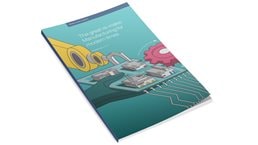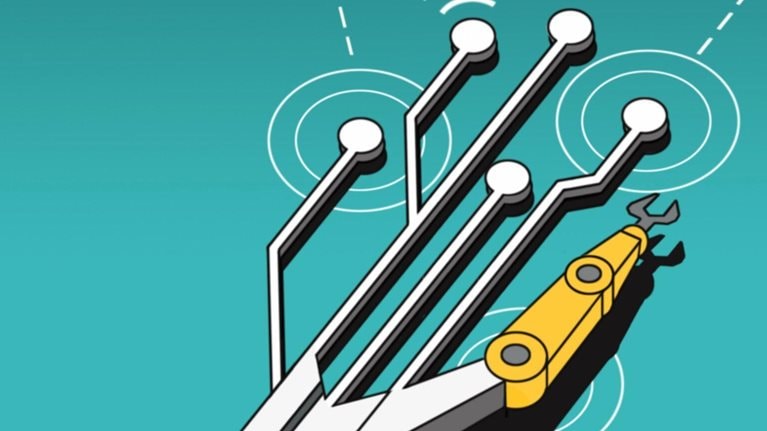Additive manufacturing (AM)—the process of making a product layer by layer instead of using traditional molding or subtractive methods—has become one of the most revolutionary technology applications in manufacturing. Often referred to as 3-D printing, the best-known forms of AM today depend on the material: SLS (selective laser sintering), SLA (stereolithography), and FDM (fused deposition modeling) in plastics, and DMLS (direct metal laser sintering) and LMD (laser metal deposition) in metals. Once employed purely for prototyping, AM is now increasingly used for spare parts, small series production, and tooling. For manufacturing with metals, the ability to use existing materials such as steel, aluminum, or superalloys such as Inconel has significantly eased the process of adopting AM.
Stay current on your favorite topics
Meanwhile, the number of materials that AM can handle is constantly expanding. A wide range of new plastics has been developed, along with processes and machines for printing with ceramics, glass, paper, wood, cement, graphene, and even living cells. Applications are now available in industries ranging from aerospace to automobiles, from consumer goods (including food) to health care (where artificial human tissue can be produced using AM) (Exhibit 1).

Additive advantages
Compared with traditional production methods, AM offers enormous benefits, including less hard tooling and assembly. In the long run, AM can completely change the way products are designed and built, as well as distributed, sold, and serviced (Exhibit 2).

Adoption of AM has been highest in industries where its higher production costs are outweighed by the additional value AM can generate: improved product functionality, higher production efficiency, greater customization, shorter time to market (that is, improved service levels), and reduced obsolescence, particularly in asset-heavy industries. Engineering-intensive businesses such as aerospace, automotive, and medical can accelerate prototyping, allowing them to explore completely new design features or create fully individualized products at no extra cost. High-value/lower-volume businesses see faster, more flexible manufacturing processes, with fewer parts involved, less material wasted, reduced assembly time for complex components, and even materials with completely new properties created. And spare-parts-intensive businesses in fields such as maintenance, repair, and overhaul get freedom from obsolete parts, faster time to market, more local and on-demand production opportunities, and independence from traditional suppliers.
Manufacturing market potential
Several analyst reports expect that the direct market for AM will grow to at least $20 billion by 2020—a figure that represents just a fraction of the entire tooling market today.1 However, we believe that the overall economic impact created by AM could be much higher, reaching $100 billion to 250 billion by 2025, if adoption across industries continues at today’s rate. Most of that potential will come from the aerospace and defense, automotive, medical, and consumer-goods industries.
Would you like to learn more about our Operations Practice?
Meanwhile, various stakeholders are accelerating the overall market development for AM. Large OEMs are investing significantly in R&D and building internal centers of competence, while other large corporations—such as HP, from the traditional printing business—are entering the market. Major governments are setting up R&D funds, including the European Union’s Horizon 2020 program, or are starting capability-building programs for their workforces, as in Korea.
Universities are partnering with manufacturers’ research centers to create innovation centers for applied R&D, with examples including Advanced Remanufacturing and Technology Centre in Singapore and RWTH Aachen University/Fraunhofer Institute for Production Technology. Finally, a vibrant start-up scene has arisen as most patents on existing AM technologies have run out, leaving space for new (as well as established) players from various industries to enter at all points on the value chain. New design and service companies are being set up and new technologies developed, such as by BigRep and Carbon3D.
AM’s limitations
Despite all of the optimism about AM, there are still major challenges to be overcome before the technology enjoys truly widespread adoption (Exhibit 3).

- Lack of design knowledge. There is still a significant worldwide skills gap when it comes to product design for AM. Capturing the technology’s full potential often requires completely rethinking the way products are designed, because AM allows nearly complete freedom: product designs can be calibrated to eliminate unnecessary materials, and inner or organic structures can be incorporated, thus overcoming the limitations of traditional milling or injection molding. Our sense is that companies are only scratching the surface of what is possible.
- High production costs. This is the major barrier to more widespread use of AM. Although AM avoids the high up-front tooling costs that traditional processes (such as injection molding) require, those advantages tend to fade quickly as production volume increases. The good news, however, is that with plastics, the volume threshold where AM has an advantage is increasing, with one AM company claiming to have pushed it to 5,000 units for a relatively small, simple object. But even at low volumes, AM with metals often remains much more expensive than traditional methods because of several interconnected factors: high materials costs, slow build-up rates, and the long machining hours that result, high energy consumption, and postprocessing costs, which are often underestimated.
- Limited production scale. Because most current AM machines are made for prototyping rather than series production, mass production scale is hard to attain. The next-generation machinery needs to keep reducing production costs while adding capabilities necessary to support industrial production, such as process-stability management, in-process quality control, faster changeovers, greater reliability, and easier maintenance and repair.
- Limited cybersecurity and IP protection. Current-generation AM machinery is vulnerable to two especially important security issues. The first is the protection of original designs, including the identification of parts—particularly if parts are designed in ways that make them replicable after the product is sold. The second is protecting data from cyberattacks, the risks of which are increased by tighter integration with suppliers and customers.
Manufacturers of AM machines, however, are addressing these limitations with significant results. Specialized AM service companies, along with engineering and consulting firms, are now bridging the design-skills gap. In addition, regional governments are funding AM-focused production clusters for applied R&D. Several analysts predict that next-generation machines will cut current AM production costs dramatically because of factors such as patent expiration and reduced postprocessing needs. Manufacturers will also benefit from increasing economies of scale and sourcing opportunities in low-cost countries.
AM machine manufacturers are working on better in-process control, advanced quality diagnostics, and data storage along the entire production process for certification purposes. Large AM manufacturers, including Materialise and Stratasys, suggest that AM can achieve material properties in both plastics and metals comparable to those from traditional production techniques.
We are also seeing an increasing availability of materials with properties comparable or even superior to those of existing ones. These materials include polymers such as nylon, PEEK, and ULTEM that are becoming more heat resistant and lending themselves to more applications, and metals and alloys within the standard range of available materials: industrial metals such as steel, aluminum, titanium, and Inconel; precious metals such as gold and silver; and new materials including amorphous, noncrystalline metals.
The AM value chain—players and business models
The AM landscape is diverse. In the plastics printing market, larger, integrated players cover the entire value chain from supplying materials to manufacturing printers to providing printing services. Several have added services by making targeted acquisitions. The larger players are also very active in creating new use cases in particular industries, driving sector-wide adoption and sale of equipment. In the metal printing market, by contrast, relatively small players focus more on certain parts of the value chain, such as in printing equipment or in printing services.
Given the investments necessary for developing the next-generation machines, many of these smaller players are looking for capital. Consolidation in the market has therefore begun. Uncertainty about which manufacturers will survive will change the face of the industry, creating risk for manufacturers investing in equipment even as improving technology holds out the promise of surmounting current barriers to the adoption of AM.
Meanwhile, in addition to the traditional material, printing, and service businesses, fast-growing niche players are starting to arise. These companies ground their entire business models on AM, ideally combined with digital sales and service models. Align Technology, with its product Invisalign, provides an alternative to metal dental braces; there are similar examples from Sonova for in-ear hearing aids, Mykita with eyeglasses, and Shapeways with crowd design of consumer products.
New competitors are also entering the OEM market. Large players such as Stratasys and 3D Systems are certifying an end-to-end process for producing medical parts with newly developed materials, using their own printing technology and offering printing services to customers such as hospitals, which formerly purchased from OEMs.

The great re-make: Manufacturing for modern times
This 21-article compendium gives practical insights for manufacturing leaders looking to keep a step ahead of today’s disruptions.
We see little evidence of a race toward a single technology, since—because of factors including variations in cost, available materials, and surface finish—the existing technologies serve different purposes. To explore the potential of AM, manufacturers therefore often need access to more than one technology, which they can get via specialized service providers that offer all the key ones. This picture may change, however, if new entrants dramatically increase performance by improving an existing technology or creating a completely new one.
Disruptive potential of AM for value chains and traditional company functions
People tend to overestimate the short-term impact of technologies and significantly underestimate the long-term impact. Yet there is currently a lot of uncertainty about the long-term impact of AM on traditional value chains. Understandably, the issue is being raised by traditional players such as logistics companies that will be directly affected, and by governments that aim to prepare their manufacturing ecosystems and workforces for changes that may be coming soon.
How will the traditional way of serving markets change, and what are the implications for traditional plant setups and value chains? As far as production and distribution are concerned, a few things seem clear. Advantages from production in low-cost countries will likely diminish. New, customer-centric plants will emerge, allowing the finishing of products according to local demand and significantly reducing the need for long-distance transport of finished goods. We may also see new production-network models—for example, production of half-finished products in low-cost countries, with finishing done close to customers to adjust for local taste, seasonality, and similar factors.
With these changes in production capabilities will come equally dramatic shifts in company functions and their relative importance on the value chain. The ability to make completely customizable products will shift the traditional manufacturing mind-set of “What is feasible?” to one of “What is possible?” Design capabilities will therefore become an even more important strategic asset.
Company functions of today will also change when, for example, operators skilled for one production line will need to operate new AM production lines that produce a large variety of products. Traditional engineers will need to be trained in AM design. Marketing and sales, meanwhile, will need to learn how to market individualized products that can be produced anywhere in the world.


